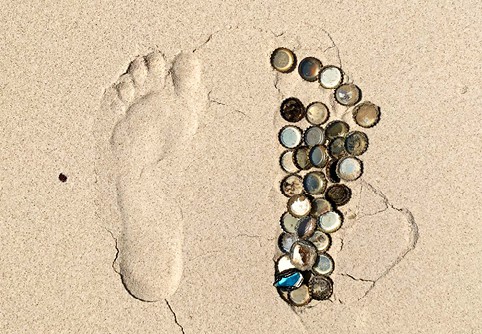
Friday read: Can sustainability and luxury co-exist?
Helen Davies, senior production and sustainability manager at brand agency LOVE, argues that super premium brands need to do much more than look and feel good in today’s world of conscious-consumerism.
There’s a tension between luxury and sustainability – and that’s nowhere more apparent than in the premium tiers of the wines and spirits industry. Weighty glass bottles are the norm. Lavish, highly decorated presentation boxes are the expectation. Step into the alcohol department of any luxury retailer and you’ll see very few naked bottles. The higher the value of the liquid, the higher the expectation for additional decoration and packaging. Hardwoods, leathers, velvets, ribbons and gold – these trappings are designed to be outward signifiers of a brand’s quality, luxury and tradition, and also to enhance giftability in an industry where that is so important.
But all this excess comes at a cost to the environment, emissions and recyclability. Can a luxury alcohol brand become truly sustainable without breaking these expected brand codes? Would a minimally packaged product sell as well as its highly decorated counterpart?
We’ve seen many wine and spirit brands, including the luxury tier, focusing on sustainability in varied and valuable ways beyond packaging. Regenerative agriculture in vineyards, water stewardship in the distilling process, energy reduction and renewable energy use and B Corp certifications are all examples. Such Corporate Social Responsibility initiatives and the journey to net zero are the cornerstones of sustainable business and not to be discounted, but they do not address the weighty and wasteful packaging issue.
There are a number of new sustainable primary packaging formats in mass to mid-range alcoholic drinks – refill pouches, bag-in-box, aluminium bottles and wine in PET are all great. But these formats are unsuitable for longer term storage of fine wine, the carbonation of Champagne or keeping high-proof and high value spirits safe. 100% recycled glass may be the answer here, as making new containers from recycled glass generates huge savings in energy use, CO2 and raw materials. Nc’nean Whisky’s recycled bottles and Château Galoupet have proven that the colouration and occasional internal blemishes of recycled glass can be a feature, not a flaw, and should not detract from the luxury feel of the product.
Changes in secondary packaging and gift boxes are also happening. Slowly, but surely. The unrecyclable elements of the most common rigid gift boxes (magnets to keep them closed and plastic vac-formed bottle fitments) can be phased out with just some design tweaks, leaving a box that feels no less premium than the original, but is now entirely recyclable (Hennessy does this very well).
Plastic fitments for tin packaging are being replaced with moulded paper pulp, as in the case of Veuve Clicquot. Taking this further, paper pulp can be the star of the show on its own, creating super lightweight, easily recyclable and beautifully tactile packaging pieces for brands like Ruinart and Perrier-Jouët.
Château de Malengin Eve produced a wildly creative and brightly coloured concertina paper magnum gift pack that can convert into a lampshade (it does have magnets, but they are easily removed). Even the humble folding carton can be elevated to premium levels with sumptuous deep embossing and artist collaborations (Perrier-Jouët with designer Bethan Laura Wood, for example); or beautiful print and fine finishes, such as the limited editions from Compass Box whisky.
It’s at the super luxury tier that these good practices tend to come unstuck under the weight of tradition and expectation. Limited release and high age expression whiskies with their eye-watering price tags usually come packaged in the most unsustainable and unrecyclable of packs. It could be argued that many of these whiskies are treated as collectors’ items, never to be consumed. Or if they are cracked open, they will be consumed over the course of months or years. So, the packaging is less immediately wasteful than with the single evening’s enjoyment of wine or Champagne. But this argument feels more like an excuse to continue the wasteful practices of excess that have come to be expected from the category.
Premium, luxury, giftable does not have to mean unrecyclable and unsustainable, as some luxury brands are starting to prove. Islay-based distillery Bruichladdich recently revamped the packaging of The Classic Laddie through a lighter bottle with higher recycled glass content and removing entirely the secondary packaging. This reduced the single malt whisky’s carbon emissions by 65%.
Small steps towards recyclability that don’t rock the boat in terms of format and perception are all well and good, but the demands of a younger consumer base are likely to require far bigger changes and true brand bravery.
Research suggests the age range of luxury consumers is getting younger, with the demographics of premium wines and spirits buyers shifting similarly. These ‘young luxurian’ drinkers are predominantly Millennials, but Gen Zs will soon age out of their RTD and seltzer phase, and are already looking towards premium brands. They are also the most socially and environmentally conscious group and will be demanding change.
I look forward to the day when more luxury wine and spirit bottles are sold in leaner, greener and easier to recycle packs (or even naked). When brands will be more open about the challenges and wins of their own sustainability journeys, taking some risks and perhaps learnings from their mass market counterparts. We are all pushing towards a lower waste, more sustainable future, so luxury drinks brands should start shedding the weight of expectation and join that journey.




